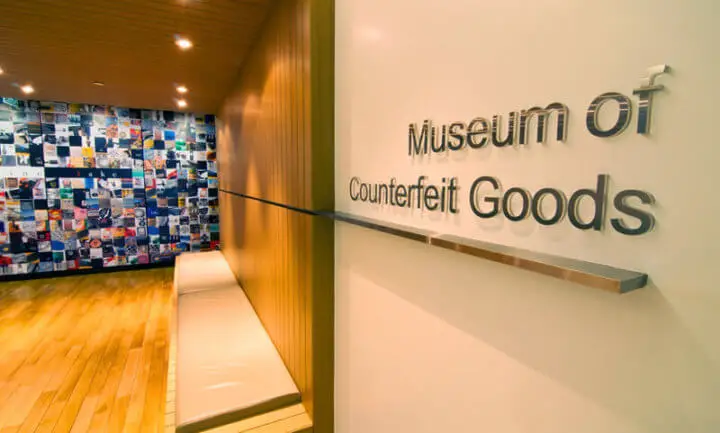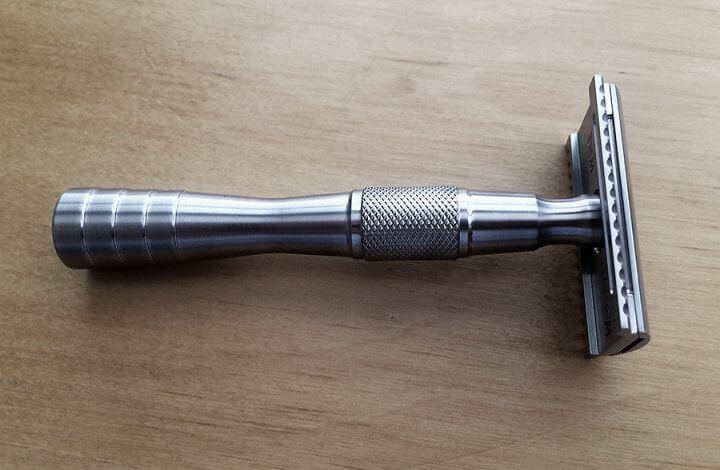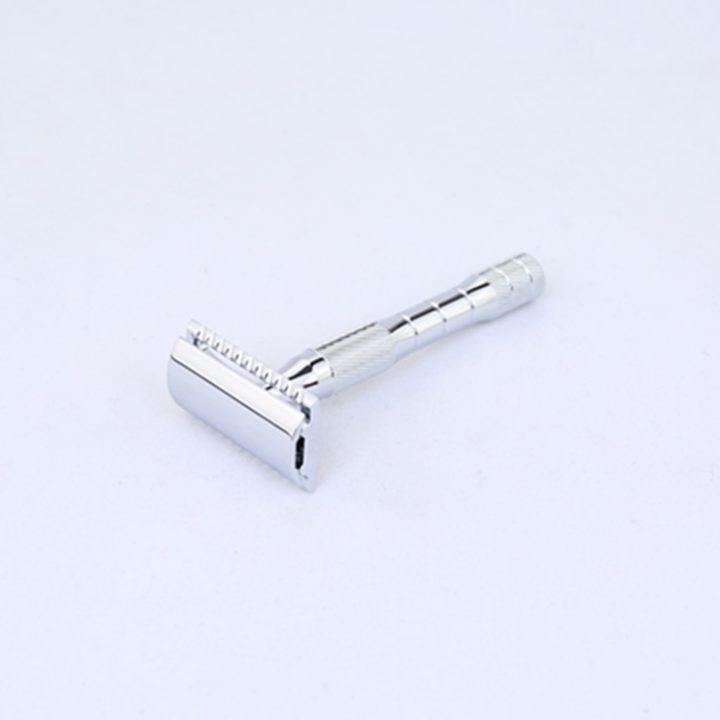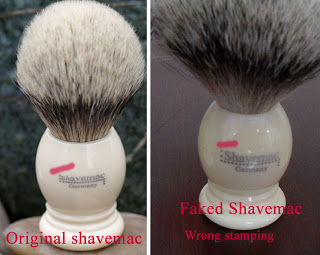
Updated November, 2019] If “imitation is the sincerest form of flattery,” the manufacturers and vendors of the wet shaving world must be very flattered indeed. It seems like when someone happens upon a product that generates a lot of buzz in the wet shaving community, others will try to hop on the bandwagon. Sometimes it’s an homage. Sometimes it’s a little more sketchy.
Terminology
For the purposes of this article I’m dividing the content into three categories. Here is how I define them:
Copy: a product that is similar to–but not exactly the same as–another product. An example might be a razor that is similar-looking to another razor but is larger or lighter or otherwise distinguished from the original.
Clone: a product that is identical but sold under different circumstances, such as an “original equipment manufacturer” (OEM) product sold under different brand names.
Counterfeit: a product expressly sold to fraudulently deceive the customer into thinking they were receiving a genuine, name-brand product.
Patents
It’s also worthwhile to mention that, at least when discussing copies and clones, many of the patents that shaving hardware (e.g. razors) designs are based on have long-since expired. This tends to “muddy the water” somewhat, especially in the minds of some manufacturers in the Far East where the terms like patent and copyright seem to mean they have the “right” to “copy” something….
And speaking of patents, it should also be noted that there are two basic kinds of patents and that they are viewed differently in the eyes of the law (at least in the United States):
According the the U.S. Patent And Trademark Office, “In general terms, a ‘utility patent’ protects the way an article is used and works (35 U.S.C. 101), while a ‘design patent’ protects the way an article looks (35 U.S.C. 171). The ornamental appearance for an article includes its shape/configuration or surface ornamentation applied to the article, or both. Both design and utility patents may be obtained on an article if invention resides both in its utility and ornamental appearance.” [emphasis mine]
Utility Patents are much harder to obtain than Design Patents, but Utility Patents have stronger laws protecting them.
So with this background in mind let’s examine the state of making stuff in the wet shaving world….
Copy
As I previously mentioned, many razor patents have lived their life and have expired. So there is really nothing “illegal” about creating a copy, as long as other laws are not broken. Brad Maggard of Maggard Razors offered this observation:
“There are plenty of Copies on the market – for example, the Baili BR-179 is a pretty darn close copy of the Gillette superspeed. The Maggard Slant is a copy of the Mulcuto slant from the 1930s. The iKon OC Deluxe is a copy of the Gillette NEW. There are no laws being broken here with “copying” an existing product that does not have any valid patents, and it allows for manufacturers to take proven designs from the past and create inexpensive, functional goods.
The downside here is that since nobody can protect a razor handle design or brush handle design, in the Artisan community, people copy others work very often. In addition, larger manufacturers are copying small artisan designs as well – take for example the Wolfman handle:

and then the Chinese made copy:

Or, take the Maggard MR5 – a handle that I designed myself, I still have the series of emails with Photoshop sketches that I sent to my manufacturer. The Pakistani’s got ahold of one, and started copying it, and now it is being sold by no less than about 10 other retailers.
Am I upset? Well, I’m a little peeved. But there isn’t anything I can do about it – and heck, I’m doing the same thing by selling Edwin Jagger head “copies”
We also designed the MR8, MR22, MRT (Travel). Several of those models have been sold by other retailers as well, after being offered the designs by Pakistani sellers.”
Joe Abbatangelo from Italian Barber believes almost every service or product can be “inspired by” another and part of an evolution:
“A smart business analyst told me a long time ago, the key to business success is being able to see a void and fill that void. Whether the void is a tweak is design/formula, cost, packaging, marketing, etc. If you are successful, you’ve filled a void in the market.
“If you try to copy, you still need a gateway (a void) to be successful and you need to execute brilliantly. If you are a company that gets copied and in a short period of time and your niche dissolved, you left the door wide open to that. A smart business can make sure the voids are small to nil using various techniques and knowledge (ie. Google, Facebook, Amazon, Costco, etc). Two businesses tried to copy two of our razors, the Mamba and the Stealth, both failed miserably because they did not understand about voids. Watching the process was enjoyable to me because I found it very amusing. I got hundreds of emails asking if I was mad… hell no! I actually thought it was a compliment and it was awesome watching them give it a go. One of the owners actually called me on the telephone and asked me (after a lot of conversation) why I wasn’t upset, I told him, because it only makes me stronger in the long-run.
“Business is so much fun, and it’s fun because of smart capitalistic competition. I love running businesses because it’s like a chess match but with thousands of more variables. We are born and then one day we die… let us live and enjoy the process. Believe me, innovation will not die because of copy cats, where there is a void, there is a smart capitalist ready to fill it, what’s far more important is having a society that welcomes and embraces capitalism.”
Douglas from Phoenix Artisan Accoutrements considers copies to be a “race to the bottom” unless there is a conscious choice from the consumer to support an artisan:
“Everyone likes a good deal, I get that, but sometimes it’s just plain short-sighted. When Chinese companies copy or duplicate razors it hurts our budding industry. I can only speak of my own personal experience but I suspect others will feel and experience the same as this becomes common practice in our niche.
“After this recent event I am really not sure if it’s viable or sustainable for us to do this anymore, for if the next razor was a success, a huge faceless Chinese manufacturer would be reproducing them months later at half the price! Or better still, wholesaling it to my competitors. Creating a price war and race to the bottom…lovely. So why would we even go down that road?
“This is what I mean when I say it hurts our budding industry. More small guys will back off from this practice and we will be back to everything looking the same again. In short, mediocrity wins. (this is already seems to be happening.)
“By supporting this practice we also send China a message that this behavior is OK. It’s happening to me today but it will happen to others tomorrow. I say ‘dance with the one who brung ya’, stick with the artisans and vendors you know and that give back rather than hopping on the knock off train…at the end of the day it’s good for all involved and keeps things interesting.”
Clone
I believe here is where we start getting into issues of ethics and law. On the one hand there are OEM arrangements where a manufacturer’s product is simply sold through wholesale arrangements to others. The prime wet shaving example would be various razors sold, quite legally and ethically, under different brands. There are many examples and there is certainly nothing nefarious about this arrangement.
On the other hand sometimes OEM’s might “play with” designs that customers bring to them for production. A prime example that has generated a lot of confusion is the difference between the Baili BD179 razor and the Viking’s Blade “Chieftain” razor. Viking’s representative explains in detail:
“When we first approached Baili with our original design, Baili (understandably) rejected it. They were simply not in the business of making branded custom molds for small businesses like ours (Perhaps on a more skeptical view, they could not use it for OEM purposes).
“However, after some convincing through many layers of staff, a production manager at Baili agreed to make a custom mold for us. Therefore, finally the Chieftain was out on the market for sale.
“When we achieved #1 bestselling position on Amazon (admittedly with a lot of luck), 2 things happened:
- Baili posted our design on Alibaba to boost their reputation by insinuating that it’s their design
- As a result, many Amazon sellers approached Baili to reproduce OUR design (thinking that they’re just rebranding a Baili razor)
“So, to ‘legally’ get themselves around this, Baili told us that our branded mold was broken. True or not, we will never know.
“As a result, Baili suggested re-building a new mold for us, which was much simpler than our original design. Among other things:
- the razor head became much lighter;
- the safety bars were reduced and thinned out; and
- our integrated brand name was removed.
“To convince us to go ahead with the 3rd point above, Baili also said this: due to the minimal height of the raised brand name on the mold, after polishing, the text was often accidentally sanded down.
“Hence, Baili suggested that having a blank surface with a laser-etched brand name would solve the problem.
“We agreed. To be honest it was very careless on our side as we Aussies don’t really suspect others until we get done for.
“Anyway, since Baili came up with those suggested minor modifications, they believed they could now OEM the new brand-less mold.
“They even registered this simplified design in China (of course that happened after we registered our design in the US). The rest is history.
“Of course we were furious and a lot of drama started. But to remedy the situation we immediately rebuilt a new mold.
“A bigger, better and upgraded mold. This time we made sure our brand was part of the mold itself.”
“People need to stop speculating that we “rebrand” Baili, given that both Baili and Vikings Blade have publicly disputed such speculations.”
Read the complete settlement statement HERE.
Another unfortunate cloning story comes from the Version 1 design of Supply’s The Single Edge razor. A clone suddenly appeared on the UK market. As Supply tells the story on their Facebook page:
“As others have pointed out, this is unfortunately an exact replica of our razor, The Single Edge. The people behind it are actually the original manufacturers for my razor that I fired after they delivered thousands of defective products and refused to correct them. They have all of my design files so it’s literally an exact copy (except for the strange redesign of the injector pack).”
Counterfeit
Here we get into straight-up criminal territory. Admittedly they are not very common, but they can be the most damaging to a legitimate brand’s reputation.
And some manufacturers in the far-east make it fairly easy to do. Just search Alibaba for a product with a brand name and you will see many examples. Some even list the brand name in their product title. Others will boldly state that they will put on any logo the buyer specifies onto their product. Of course that could mean they will put on a logo of the company that contracts with them, but it also means an unscrupulous person could specify a logo of a competing product–the manufacturer doesn’t care.
Several years ago there was a counterfeit Shavemac shave brush:

The counterfeit brush has a capital “S” in Shavemac; the genuine brush’s Shavemac logo has a lower case “s.”
Probably the most serious counterfeiting problem in wet shaving relates to Edwin Jagger razors. Neil Jagger explains:
“As is the case with most luxury and high-end designer brands, Edwin Jagger is aware that its products may be targeted by counterfeiters wishing to cash in on the ever popular and growing male grooming market. There is clear evidence that consumers wishing to start DE shaving may look for a low-cost razor to start their shaving experience.
At the start of its manufacturing history Edwin Jagger only designed and manufactured high end/cost products however, the growing grooming market and desire from a wide range of end users led to the introduction of a somewhat more affordable collection in 2010.
Recognition of the staggering and continued growth in demand for DE razors across a worldwide market inevitably creates opportunities for counterfeiters to reproduce copies of the most highly prized examples. Edwin Jagger, a luxury brand and one of the first manufacturers to market with its DE89 range, is a likely target for so called ‘knock-offs’. As a company, we reluctantly acknowledge this development but work tirelessly to identify and challenge this illegal industry wherever possible.
N.B. Edwin Jagger does not share component tooling or production processes with any other manufacturer and the latest set of DE head tools are exclusive to Edwin Jagger.
We have been made aware of a significant quantity of counterfeit Edwin Jagger Double Edge Safety Razor Heads originating from China, India and Pakistan. The few examples of counterfeit Double Edge Safety Razor two-part razor heads we have seen have been of low quality finish, displaying signs of inaccurate die casting and machining, both parts coated with chrome surface finishes that vary. Recreating and maintaining essential die cast tooling for the effective production of Double Edge Safety Razor components is very costly.
‘Copy Cat’ manufacturers will find the perfect reproduction of an Edwin Jagger Double Edge Safety Razor Head is both challenging and expensive to replicate, typically leading the counterfeiter to introducing cost saving processes and lower measures of quality.
What You Can Do
So what can the wet shaving consumer do? Just being aware of these issues is a good start!
If you think you have a counterfeit shaving product here are some suggestions:
- Know legitimate sources before you purchase. Be aware that Amazon has a growing counterfeiting problem.
- Contact the vendor you purchased the product from. A reputable vendor will try to “make things right” in some way.
- Contact the brand. They may not be able to help you or get your money back but at least they will be aware of the problem.
Addressing copies and clones also benefit from and educated shaving customer. While some issues revolve around “philosophy,” it also pays to know the landscape around pricing and distribution.
What are your thoughts on copies, clones, and counterfeits in the wet shaving world? Leave a comment below!
(Like this article? Please share it!)

Thanks for a great article, Mantic59! I love these types of articles that get down to some other parts of the shaving culture.
However, there are some points I dislike about the ‘western world’ producers. It seems that while everyone is playing by their rules, it’s all fair and square. And by that I think of a company owning a photoshop or autocad copy, and no machinery whatsoever + they have no experience in creating shaving hardware. And they want to offer the ‘whole package’ and not just what they’re good at. So they look for subcontractors to actually make the razors, and lo and behold, the Far East ones are cheaper than the lot. It’s many times the producers, looking to cut costs, that engage in a ‘race to the bottom’. They get played later on, and suffer the consequences. To me it’s an equivalent to when a consumer buys the cheapest of the bunch only to see that the shaver has issues by the dozen. In any case, I urge the producers to first be able to build it, and then try. That way you’ll own the whole stack by the vertical and have full control over your product. There’s no halfstepping in this.
For myself, I don’t even buy goods from the US, since I live in Europe. I have limited myself to European brands that are quite nearby and for whom I have multiple sources claiming they produce the razors themselves, mainly Merkur, Giesen & Forsthoff 3pieces, and Fatip.
Here, hope I was a constructive reader 🙂
Enjoy your shaves guys.
Thanks for the reminder about this, and especially referencing Amazon and their growing counterfeit issue. They just make it so easy to order from them if you are a prime member. And I think at least once I may have had counterfeit blades from Amazon. Wanted to note that last week, when I wanted to try my first adjustable razor (Parker Variant) I ordered from West Coast Shave because I trust them, but they were completely price competitive and I did get free shipping. Now thinking I won’t be going to Amazon for blades anymore either. Guess we should all remember to consider that if we want our fave specialty shaving store to continue to be there they need our business.
I try whenever possible to avoid the Zon.
Thank you for this very detailed article, especially around the issue between Baili and Vikings Blade.
I bought a Baili BD179 from AliExpress and later on a Vikings Odin Chieftain purely for its unique colors. I initially expected the Odin to be the same as the Baili but that didn’t seem to be the case.
While the Baili 179 is an ok razor, the Vikings Odin is a superior in every way. You do get what you pay for.
Sometime we have to be aware of our own dealers copying a product that we worked so hard to created!
Rembrandt was copied and faked while we was alive, Picasso used to buy whole series of fake Picasso and claim it as his own!
So try to do something very different with small margin of profit and you MAY be safe from copiers!
I completely agree any manufacturer has to be aware of vendors stealing idea/products.
But please, don’t start comparing yourself Rembrandt and Picasso (or even just using them in the same sentence as what you may do). That just makes you sound silly.
The hypocrisy of PAA on this topic is just laughable.
He is complaining about the Chinese going all out producing the exact same razor he is copying.
The patent expired long ago so it is all nonsense.
Most wet shavers don’t care one bit about copying if it’s cheap enough.
This is an interesting article. I was aware of counterfeits and its’ effect on vendors, but I hadn’t really considered the copies and clones. It also got me thinking about a Parker Variant that I have which developed problems with a loose head just after 1 year of use. I bought it through Amazon, but wondered if I had a counterfeit as no one else seemed to have the same problem. In doing more research, though, I found that some people experienced quality control issues with earlier models. Perhaps that is what happened with mine. Anyway, I replaced it with an Edwin Jagger DE87 which I like a lot but found to be more mild than the Parker Variant. This article mentioned that Maggard makes an aggressive head that fits the Edwin Jagger razor. I’ve ordered that aggressive head from Maggards, along with a sample of the Captains Choice Bay Rum saving soap (after seeing last week’s article on The Sharpologist). The more aggressive head on an Edwin Jagger body does seem to fill a void, as Joe Abbatangelo mentions.
I did buy that Maggard head after my original broke for my Edwin Jagger DE89 and it certainly was more aggressive. Not sure if I shave with a heavy hand or my skin is extra sensitive but it ended up being too aggressive for my chin area especially. Ironically, as I just noted in another comment, I went the opposite direction and got a Variant to help with that. 🙂 Going to read some more Sharpologist and see if I cant improve my lather and my technique also.
Comments are closed.